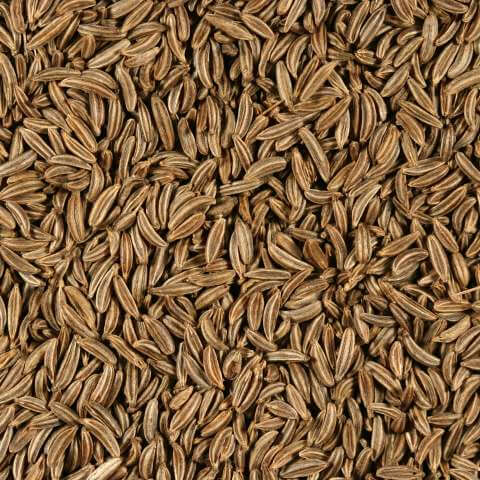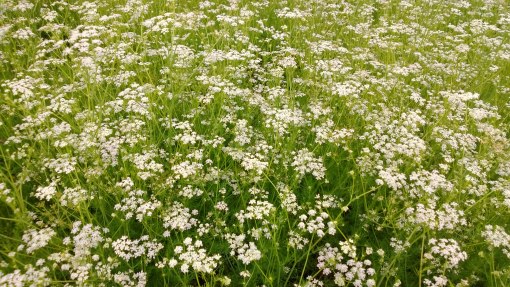Since 2014, the Czech Republic registered a variety of caraway with a shortened growing season – APRIM. The benefits of APRIM varieties are particularly stable yield that are almost comparable with 'classic' varieties of biennial caraway, and a shorter growing season, which allows its sowing after the harvest of the forecrop. In terms of sowing date, it is advantageous to eliminate some pest damage, especially damage by caraway mind (aceria carvi) and due to the shorter growing season also less space for weed infestation of caraway and land for subsequent crops.

Brief description of the variety APRIM
It is a medium early variety, the plants are moderately high, less to medium resistant to lying. The variety is moderately resistant to resistant to fading achenes, moderately resistant to resistant to attack by Mycocentrospora acerina. The variety is resistant to winter kill. Due to shorter growing period it is rarely attacked by aceria carvi. Oil content in the seed is low; the proportion of carvone is standard.

Requirements for the soil and environment
Caraway APRIM can be successfully grown in corn, sugar beet and potato production areas. It is not significantly soil demanding, but it is logical that the better and more fertile soil the better plant growth and caraway development and consequently also yield.
Position in a crop rotation
It is classified primarily after cereals harvested on time. They can be grown after dicotyledonous crops. Root crops, fabaceae plants and legumes are also suitable. Especially in terms of the subsequent weed infestation. Winter rape is not suitable forecrop, especially in terms of the subsequent weed infestation.
Soil preparation and fertilization
After the plot ploughing the usual preparation before sowing with nitrogen, phosphorus and potassium treatment follows. It is suitable to use a compound fertilizer NPK with a dose of 30 kg nutrients per hectare.
In spring it is fertilized by N fertilizer (eg. LAV, LAD, SA, et al.), the minimum recommended dose is 80 kg per ha−1. It is effective to divide this dose, or alternatively bigger one, into 2 in a ration of 50:50 or 60:40. Sowing: Caraway of variety APRIM is sown in rows 12–15 cm wide, to a depth of 1–2 cm. Date of sowing is around 15. 8. to the end of August with regard to the cultivation area and weather. Sowing is followed by harrowing or alternatively rolling by light rollers. The seed rate is determined by the value of the seed; however the ordinary seed rate ranges between 12 to 15 kg per ha−1 (3–3.5 Millions germinating seed).
Treatment during vegetation
Given generally quite long sprout of caraway plants, approximately 14-21 days after seeding; there is a practical necessity to perform pre-emergent herbicidal protection against annual dicotyledonous weeds. In the current time, there is for preemengence use in Caraway registered only herbicide Bandura at a dose of 3.0 to 3.5 l ha−1. Graminicidal preparations (e.g. GARLAND FORTE GRAMIN, TARGA SUPER 5 EC, et al.) can be used against monocotyledonous annual and perennial weeds after germination. In case of application of these preparations the caraway should have at least four real leaves, i.e. stage BBCH 14 and more.
Simultaneously, from this growing and developing stage it is possible to apply corrective or additional herbicide treatments against dicotyledonous weeds (eg. AFALON 45 SC, STARANE 250 EC, et al.).Selection of herbicide preparations for postemergence use is primarily done according to the actual occurrence of various weed species at a site. It is appropriate to deal with a control of perennial dicotyledonous weeds on the land, especially Cirsium arvense, already in forecrop or by non-selective herbicide before planting, but if necessary, it is possible to use a herbicide BUTOXONE 400. The principle is, that primarily dicotyledonous weeds should be regulated in the autumn, because their liquidation in the spring of utility year would have to face the selectivity of herbicides against caraway. Currently, there are simultaneously running field trials and the acts leading to applying for registration of other herbicides that could be used in the caraway cover.
In case of need of consultation about the possibility of using various herbicides, but also a fungicide and insecticide products or general plant growing matters, please contact us on e-mail: agritec@agritec.cz, or else: prokop@agritec.cz.